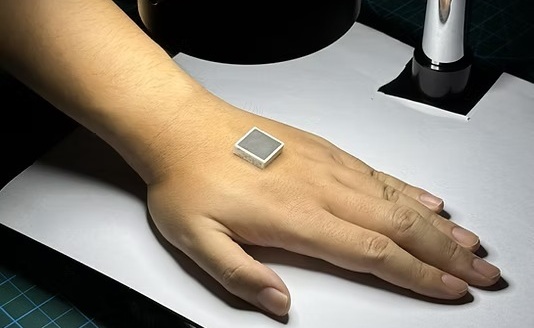Novel Technique Uses Lasers to Image Living Tissues
|
By Daniel Beris Posted on 16 Nov 2016 |

Image: Researchers found embedded nanoparticles could improve regular microscopes six-fold (Photo courtesy of MIT).
A new imaging technique uses tiny embedded particles to illuminate cellular structures in deep tissue and other dense and opaque materials.
Developed by researchers at the Massachusetts Institute of Technology (MIT, Cambridge, MA, USA), Massachusetts General Hospital (MGH; Boston, USA), and the Jožef Stefan Institute (Ljubljana, Slovenia), the particles are made from lead iodide perovskite, a material that absorbs and traps light efficiently. When a laser beam is projected at the particles, they emit a normal, diffuse fluorescent light. But if the incoming laser's power is tuned to certain threshold, the particles will instantly generate laser light.
The tiny, 6-micron-long particles have a rod-shaped geometry – much like chopsticks – and can allow a specific wavelength of light to bounce back and forth along the particles' length, resulting in images that can be captured at resolutions six times higher than current fluorescence-based microscopes. According to the researchers, the optical technique, called LAser particle Stimulated Emission (LASE) microscopy, could be used to image a specific focal plane, or a particular layer of biological tissue. The study was published on November 4, 2016, in Physical Review Letters.
“Theoretically, scientists can shine a laser beam into a three-dimensional sample of tissue embedded throughout with laser particles, and use a lens to focus the beam at a specific depth,” said lead author MIT graduate student Frederick Sangyeon Cho, MSc. “Only those particles in the beam's focus will absorb enough light or energy to turn on as lasers themselves. All other particles upstream of the path's beam should absorb less energy and only emit fluorescent light.”
“Our idea is, why not use the cell as an internal light source? We can collect all this stimulated emission and can distinguish laser from fluorescent light very easily using spectrometers,” concluded Mr. Cho. “We expect this will be very powerful when applied to biological tissue, where light normally scatters all around, and resolution is devastated. But if we use laser particles, they will be the narrow points that will emit laser light. So we can distinguish from the background and can achieve good resolution.”
Perovskite, named after Russian mineralogist Lev Perovski (1792–1856), is composed of calcium titanate, and was discovered in the Ural Mountains by Gustav Rose in 1839. Perovskites have excellent light-emitting properties, and have been used to make light-emitting diodes and optically pumped lasers. They may also be used to design solution-processed lasers that can be tuned across the entire visible and near infrared (NIR) spectrum by changing the chemical composition of the perovskite film.
Related Links:
Massachusetts Institute of Technology
Massachusetts General Hospital
Jožef Stefan Institute
Developed by researchers at the Massachusetts Institute of Technology (MIT, Cambridge, MA, USA), Massachusetts General Hospital (MGH; Boston, USA), and the Jožef Stefan Institute (Ljubljana, Slovenia), the particles are made from lead iodide perovskite, a material that absorbs and traps light efficiently. When a laser beam is projected at the particles, they emit a normal, diffuse fluorescent light. But if the incoming laser's power is tuned to certain threshold, the particles will instantly generate laser light.
The tiny, 6-micron-long particles have a rod-shaped geometry – much like chopsticks – and can allow a specific wavelength of light to bounce back and forth along the particles' length, resulting in images that can be captured at resolutions six times higher than current fluorescence-based microscopes. According to the researchers, the optical technique, called LAser particle Stimulated Emission (LASE) microscopy, could be used to image a specific focal plane, or a particular layer of biological tissue. The study was published on November 4, 2016, in Physical Review Letters.
“Theoretically, scientists can shine a laser beam into a three-dimensional sample of tissue embedded throughout with laser particles, and use a lens to focus the beam at a specific depth,” said lead author MIT graduate student Frederick Sangyeon Cho, MSc. “Only those particles in the beam's focus will absorb enough light or energy to turn on as lasers themselves. All other particles upstream of the path's beam should absorb less energy and only emit fluorescent light.”
“Our idea is, why not use the cell as an internal light source? We can collect all this stimulated emission and can distinguish laser from fluorescent light very easily using spectrometers,” concluded Mr. Cho. “We expect this will be very powerful when applied to biological tissue, where light normally scatters all around, and resolution is devastated. But if we use laser particles, they will be the narrow points that will emit laser light. So we can distinguish from the background and can achieve good resolution.”
Perovskite, named after Russian mineralogist Lev Perovski (1792–1856), is composed of calcium titanate, and was discovered in the Ural Mountains by Gustav Rose in 1839. Perovskites have excellent light-emitting properties, and have been used to make light-emitting diodes and optically pumped lasers. They may also be used to design solution-processed lasers that can be tuned across the entire visible and near infrared (NIR) spectrum by changing the chemical composition of the perovskite film.
Related Links:
Massachusetts Institute of Technology
Massachusetts General Hospital
Jožef Stefan Institute
Latest General/Advanced Imaging News
- New Algorithm Dramatically Speeds Up Stroke Detection Scans
- 3D Scanning Approach Enables Ultra-Precise Brain Surgery
- AI Tool Improves Medical Imaging Process by 90%
- New Ultrasmall, Light-Sensitive Nanoparticles Could Serve as Contrast Agents
- AI Algorithm Accurately Predicts Pancreatic Cancer Metastasis Using Routine CT Images
- Cutting-Edge Angio-CT Solution Offers New Therapeutic Possibilities
- Extending CT Imaging Detects Hidden Blood Clots in Stroke Patients
- Groundbreaking AI Model Accurately Segments Liver Tumors from CT Scans
- New CT-Based Indicator Helps Predict Life-Threatening Postpartum Bleeding Cases
- CT Colonography Beats Stool DNA Testing for Colon Cancer Screening
- First-Of-Its-Kind Wearable Device Offers Revolutionary Alternative to CT Scans
- AI-Based CT Scan Analysis Predicts Early-Stage Kidney Damage Due to Cancer Treatments
- CT-Based Deep Learning-Driven Tool to Enhance Liver Cancer Diagnosis
- AI-Powered Imaging System Improves Lung Cancer Diagnosis
- AI Model Significantly Enhances Low-Dose CT Capabilities
- Ultra-Low Dose CT Aids Pneumonia Diagnosis in Immunocompromised Patients
Channels
Radiography
view channel
X-Ray Breakthrough Captures Three Image-Contrast Types in Single Shot
Detecting early-stage cancer or subtle changes deep inside tissues has long challenged conventional X-ray systems, which rely only on how structures absorb radiation. This limitation keeps many microstructural... Read more
AI Generates Future Knee X-Rays to Predict Osteoarthritis Progression Risk
Osteoarthritis, a degenerative joint disease affecting over 500 million people worldwide, is the leading cause of disability among older adults. Current diagnostic tools allow doctors to assess damage... Read moreMRI
view channel
Novel Imaging Approach to Improve Treatment for Spinal Cord Injuries
Vascular dysfunction in the spinal cord contributes to multiple neurological conditions, including traumatic injuries and degenerative cervical myelopathy, where reduced blood flow can lead to progressive... Read more
AI-Assisted Model Enhances MRI Heart Scans
A cardiac MRI can reveal critical information about the heart’s function and any abnormalities, but traditional scans take 30 to 90 minutes and often suffer from poor image quality due to patient movement.... Read more
AI Model Outperforms Doctors at Identifying Patients Most At-Risk of Cardiac Arrest
Hypertrophic cardiomyopathy is one of the most common inherited heart conditions and a leading cause of sudden cardiac death in young individuals and athletes. While many patients live normal lives, some... Read moreUltrasound
view channel
Wearable Ultrasound Imaging System to Enable Real-Time Disease Monitoring
Chronic conditions such as hypertension and heart failure require close monitoring, yet today’s ultrasound imaging is largely confined to hospitals and short, episodic scans. This reactive model limits... Read more
Ultrasound Technique Visualizes Deep Blood Vessels in 3D Without Contrast Agents
Producing clear 3D images of deep blood vessels has long been difficult without relying on contrast agents, CT scans, or MRI. Standard ultrasound typically provides only 2D cross-sections, limiting clinicians’... Read moreNuclear Medicine
view channel
PET Imaging of Inflammation Predicts Recovery and Guides Therapy After Heart Attack
Acute myocardial infarction can trigger lasting heart damage, yet clinicians still lack reliable tools to identify which patients will regain function and which may develop heart failure.... Read more
Radiotheranostic Approach Detects, Kills and Reprograms Aggressive Cancers
Aggressive cancers such as osteosarcoma and glioblastoma often resist standard therapies, thrive in hostile tumor environments, and recur despite surgery, radiation, or chemotherapy. These tumors also... Read more
New Imaging Solution Improves Survival for Patients with Recurring Prostate Cancer
Detecting recurrent prostate cancer remains one of the most difficult challenges in oncology, as standard imaging methods such as bone scans and CT scans often fail to accurately locate small or early-stage tumors.... Read moreImaging IT
view channel
New Google Cloud Medical Imaging Suite Makes Imaging Healthcare Data More Accessible
Medical imaging is a critical tool used to diagnose patients, and there are billions of medical images scanned globally each year. Imaging data accounts for about 90% of all healthcare data1 and, until... Read more
Global AI in Medical Diagnostics Market to Be Driven by Demand for Image Recognition in Radiology
The global artificial intelligence (AI) in medical diagnostics market is expanding with early disease detection being one of its key applications and image recognition becoming a compelling consumer proposition... Read moreIndustry News
view channel
GE HealthCare and NVIDIA Collaboration to Reimagine Diagnostic Imaging
GE HealthCare (Chicago, IL, USA) has entered into a collaboration with NVIDIA (Santa Clara, CA, USA), expanding the existing relationship between the two companies to focus on pioneering innovation in... Read more
Patient-Specific 3D-Printed Phantoms Transform CT Imaging
New research has highlighted how anatomically precise, patient-specific 3D-printed phantoms are proving to be scalable, cost-effective, and efficient tools in the development of new CT scan algorithms... Read more
Siemens and Sectra Collaborate on Enhancing Radiology Workflows
Siemens Healthineers (Forchheim, Germany) and Sectra (Linköping, Sweden) have entered into a collaboration aimed at enhancing radiologists' diagnostic capabilities and, in turn, improving patient care... Read more








 Guided Devices.jpg)










